Sony HCDRG-22 Service manual
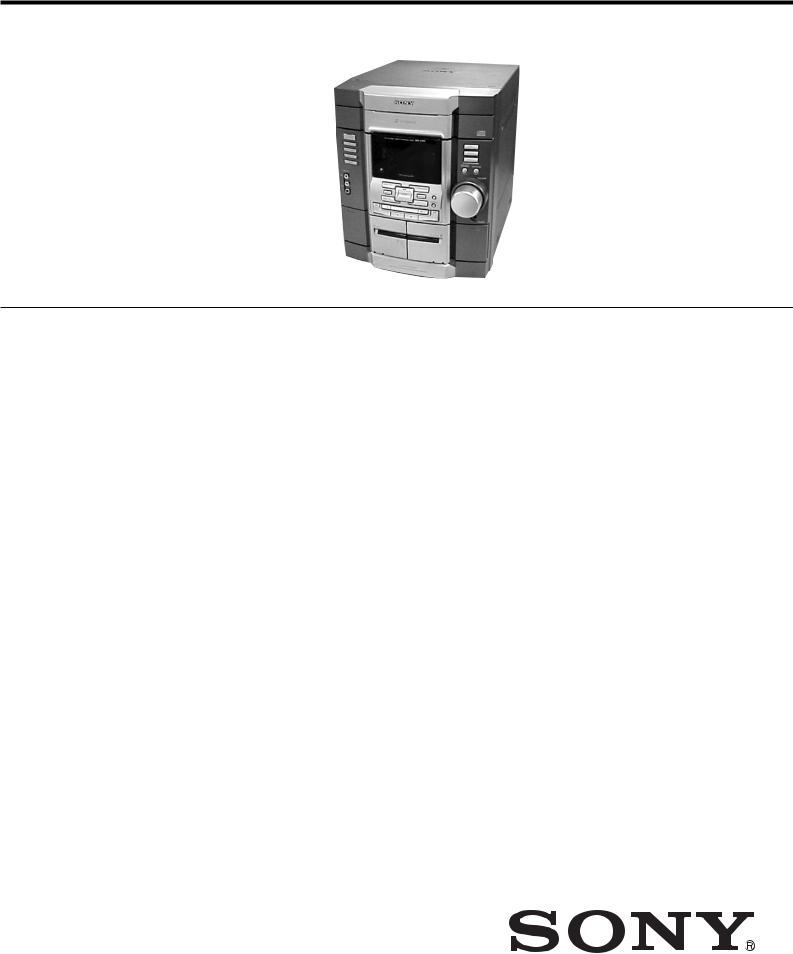
HCD-GX30/RG22/RG33
SERVICE MANUAL
Ver 1.0 2002. 04
•HCD-GX30/RG22/RG33 are the tuner, deck, CD and amplifier section in MHCGX30/RG22/RG33.
Canadian Model
HCD-GX30
AEP Model
UK Model
E Model
HCD-RG22/RG33
Australian Model
HCD-RG22
CD |
Model Name Using Similar Mechanism |
HCD-DX10 |
|
|
|
||
CD Mechanism Type |
CDM58F-K6 |
||
Section |
|||
|
|
||
Optical Pick-up Name |
KSM-213DCP/Z-NP |
||
|
|||
|
|
|
|
Tape deck |
Model Name Using Similar Mechanism |
NEW |
|
|
|
|
|
Section |
Tape Transport Mechanism Type |
CWL43FF48 |
|
|
|
|
Amplifier section
North American models: HCD-GX30
Continuous RMS power output (reference)
75 + 75 watts (6 ohms at
1 kHz, 10% THD) Total harmonic distortion less than 0.07%
(6 ohms at 1 kHz, 40 W)
European models: HCD-RG33
DIN power output (rated) 60 + 60 watts
(6 ohms at 1 kHz, DIN) Continuous RMS power output (reference)
75 + 75 watts (6 ohms at
1 kHz, 10% THD) Music power output (reference)
150 + 150 watts (6 ohms at 1 kHz, 10% THD)
HCD-RG22
DIN power output (rated) 50 + 50 watts
(6 ohms at 1 kHz, DIN) Continuous RMS power output (reference)
60 + 60 watts (6 ohms at
1 kHz, 10% THD) Music power output (reference)
120 + 120 watts (6 ohms at 1 kHz, 10% THD)
SPECIFICATIONS
Other models: HCD-RG33
The following measured at AC 120, 220, 240 V, 50/60 Hz
DIN power output (rated) 60 + 60 watts
(6 ohms at 1 kHz, DIN) Continuous RMS power output (reference)
75 + 75 watts (6 ohms at
1 kHz, 10% THD)
HCD-RG22
The following measured at AC 120, 220, 240 V 50/60 Hz
DIN power output (rated) 50 + 50 watts
(6 ohms at 1 kHz, DIN) Continuous RMS power output (reference)
60 + 60 watts (6 ohms at
1 kHz, 10% THD)
Inputs
AUDIO INPUT (phono jack):
voltage 450 mV, impedance 47 kilohms
Outputs
PHONES (stereo mini jack):
accepts headphones of 8 ohms or more
Front speaker: accepts impedance of 6 to 16 ohms
Sub woofer speaker (MHC-GX40 only):
accepts impedance of 12 to 16 ohms
CD player section
System |
Compact disc and digital |
|
audio system |
Laser |
Semiconductor laser |
|
(λ=780 nm) |
|
Emission duration: |
|
continuous |
Frequency response |
2 Hz – 20 kHz (±0.5 dB) |
Wavelength |
780 – 790 nm |
Signal-to-noise ratio |
More than 90 dB |
Dynamic range |
More than 90 dB |
Tape deck section
Recording system |
4-track 2-channel stereo |
Frequency response |
50 – 13,000 Hz (±3 dB), |
|
using Sony TYPE I |
|
cassette |
Tuner section
FM stereo, FM/AM superheterodyne tuner
FM tuner section |
|
|
Tuning range |
87.5 |
– 108.0 MHz |
Antenna |
FM lead antenna |
|
Antenna terminals |
75 ohms unbalanced |
|
Intermediate frequency |
10.7 |
MHz |
— Continued on next page —
MINI HI-FI COMPONENT SYSTEM
9-874-001-01 Sony Corporation
2002D1600-1 Home Audio Company
© 2002.04 |
Published by Sony Engineering Corporation |
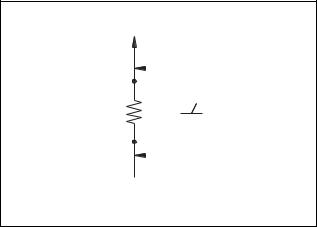
Tuning range |
|
Pan-American models: |
530 – 1,710 kHz (with the |
|
interval set at 10 kHz) |
|
531 – 1,710 kHz (with the |
|
interval set at 9 kHz) |
European and Middle Eastern models: |
|
|
531 – 1,602 kHz (with the |
|
interval set at 9 kHz) |
Other models: |
530 – 1,710 kHz (with the |
|
interval set at 10 kHz) |
|
531 – 1,602 kHz (with the |
|
interval set at 9 kHz) |
Antenna |
AM loop antenna |
Antenna terminals |
External antenna terminal |
Intermediate frequency |
450 kHz |
General |
|
Power requirements |
|
North American models: |
120 V AC, 60 Hz |
European models: |
230 V AC, 50/60 Hz |
Australian model: |
230 – 240 V AC, |
|
50/60 Hz |
Argentine models: |
220 V AC, 50/60 Hz |
Mexican models: |
120 V AC, 60 Hz |
Other models: |
120 V, 220 V or |
|
230 – 240 V AC, |
|
50/60 Hz |
|
Adjustable with voltage |
|
selector |
Power consumption |
|
Canadian models: |
|
MHC-GX30: |
125 watts |
European models: |
|
MHC-RG33: |
125 watts |
|
0.5 watts (at the Power |
|
Saving Mode) |
MHC-RG22: |
105 watts |
|
0.5 watts (at the Power |
Other models: |
Saving Mode) |
|
|
MHC-RG33: |
125 watts |
MHC-RG22: |
105 watts |
Dimensions (w/h/d) |
Approx. 280 × 325 × 412 mm |
Mass |
|
North American models: |
|
HCD-GX30: |
Approx. 9.0 kg |
European models: |
|
HCD-RG33: |
Approx. 9.0 kg |
HCD-RG22: |
Approx. 8.5 kg |
Other models: |
|
HCD-RG33: |
Approx. 9.5 kg |
HCD-RG22: |
Approx. 9.0 kg |
Supplied accessories: |
Remote Commander (1) |
|
Batteries (2) |
AM loop antenna (1)
FM lead antenna (1)
Front speaker pads (8)
Design and specifications are subject to change without notice.
SAFETY CHECK-OUT
After correcting the original service problem, perform the following safety checks before releasing the set to the customer: Check the antenna terminals, metal trim, “metallized” knobs, screws, and all other exposed metal parts for AC leakage. Check leakage as described below.
LEAKAGE
The AC leakage from any exposed metal part to earth ground and from all exposed metal parts to any exposed metal part having a return to chassis, must not exceed 0.5 mA (500 microamperes). Leakage current can be measured by any one of three methods.
1.A commercial leakage tester, such as the Simpson 229 or RCA WT-540A. Follow the manufacturers’ instructions to use these instruments.
2.A battery-operated AC milliammeter. The Data Precision 245 digital multimeter is suitable for this job.
3.Measuring the voltage drop across a resistor by means of a VOM or battery-operated AC voltmeter. The “limit” indication is 0.75 V, so analog meters must have an accurate low-voltage scale. The Simpson 250 and Sanwa SH-63Trd are examples of a passive VOM that is suitable. Nearly all battery operated digital multimeters that have a 2V AC range are suitable. (See Fig. A)
To Exposed Metal
Parts on Set
|
|
|
|
|
|
|
|
AC |
|
|
|
|
|
|
|
|
|
0.15 µF |
|
|
|
1.5 kΩ |
|
|
Voltmeter |
|
|
|
|
||||||
|
|
|
|
|
(0.75 V) |
|||
|
|
|
|
|
|
|
|
|
|
|
|
|
|
|
|
|
|
 Earth Ground
Earth Ground
Fig. A. Using an AC voltmeter to check AC leakage.
2

HCD-GX30/RG22/RG33
NOTES ON HANDLING THE OPTICAL PICK-UP BLOCK OR BASE UNIT
The laser diode in the optical pick-up block may suffer electrostatic break-down because of the potential difference generated by the charged electrostatic load, etc. on clothing and the human body.
During repair, pay attention to electrostatic break-down and also use the procedure in the printed matter which is included in the repair parts.
The flexible board is easily damaged and should be handled with care.
NOTES ON LASER DIODE EMISSION CHECK
The laser beam on this model is concentrated so as to be focused on the disc reflective surface by the objective lens in the optical pickup block. Therefore, when checking the laser diode emission, observe from more than 30 cm away from the objective lens.
Laser component in this product is capable of emitting radiation exceeding the limit for Class 1.
This appliance is classified as a CLASS 1 LASER product. The CLASS 1 LASER PRODUCT MARKING is located on the rear exterior.
CAUTION
Use of controls or adjustments or performance of procedures other than those specified herein may result in hazardous radiation exposure.
Notes on chip component replacement
•Never reuse a disconnected chip component.
•Notice that the minus side of a tantalum capacitor may be damaged by heat.
Flexible Circuit Board Repairing
•Keep the temperature of soldering iron around 270˚C during repairing.
•Do not touch the soldering iron on the same conductor of the circuit board (within 3 times).
•Be careful not to apply force on the conductor when soldering or unsoldering.
SAFETY-RELATED COMPONENT WARNING!!
COMPONENTS IDENTIFIED BY MARK 0OR DOTTED LINE WITH MARK 0 ON THE SCHEMATIC DIAGRAMS AND IN THE PARTS
LIST ARE CRITICAL TO SAFE OPERATION. REPLACE THESE COMPONENTS WITH SONY PARTS WHOSE PART NUMBERS APPEAR AS SHOWN IN THIS MANUAL OR IN SUPPLEMENTS PUBLISHED BY SONY.
TABLE OF CONTENTS
1.GENERAL ·········································································· 4
2.DISASSEMBLY ································································ 6 2-1. Case (Top) ····································································· 6 2-2. CD Door ········································································ 7 2-3. Front Panel Section ······················································· 7 2-4. CD Mechanism Deck (CDM58F-K6) ·························· 8 2-5. Tape Mechanism Deck (CWL43FF48) ························· 8 2-6. REM Board and PANEL Board ···································· 9 2-7. KEY Board ··································································· 9 2-8. Back Panel Section ····················································· 10 2-9. SUB TRANS Board, VIDEO OUT Board and
SENSOR Board ·························································· 10 2-10. MAIN Board ······························································· 11 2-11. POWER Board ···························································· 11 2-12. TRANS Board ···························································· 12 2-13. CD Board and DRIVER Board ··································· 12 2-14. SPDL Board ································································ 13 2-15. Optical Pick-up (KSM-123DCP) ································ 13 2-16. MOTOR Board, ADDRESS SENSOR Board ············ 14 2-17. Table (New), Cam (Control) and DC Motor ··············· 14
3.TEST MODE ···································································· 15
4.ELECTRICAL ADJUSTMENTS ······························· 17
5.DIAGRAMS ······································································ 19 5-1. Circuit Boards Location ·············································· 19 5-2. Block Diagrams ·························································· 20 5-3. Printed Wiring Boards – CD Section (1/2) – ·············· 22 5-4. Printed Wiring Boards – CD Section (2/2) – ·············· 23 5-5. Schematic Diagram – CD Section – ··························· 24 5-6. Printed Wiring Board – MAIN Board – ····················· 25 5-7. Schematic Diagram – MAIN Board (1/4) – ··············· 26 5-8. Schematic Diagram – MAIN Board (2/4) – ··············· 27 5-9. Schematic Diagram – MAIN Board (3/4) – ··············· 28 5-10. Schematic Diagram – MAIN Board (4/4) – ················ 29 5-11. Printed Wiring Boards – PANEL Section – ················ 30 5-12. Schematic Diagram – PANEL Section – ···················· 31 5-13. Printed Wiring Boards – POWER/TRANS Section – 32 5-14. Schematic Diagram – POWER/TRANS Section – ····· 33 5-15. IC Pin Function Description ······································· 36
6.EXPLODED VIEWS ······················································ 38 6-1. Main Section ······························································· 38 6-2. Front Panel Section ····················································· 39 6-3. MAIN Board Section ·················································· 40 6-4. CD Mechanism Deck Section (CDM58F-K6) ··········· 41
7.ELECTRICAL PARTS LIST ······································· 42
ATTENTION AU COMPOSANT AYANT RAPPORT
À LA SÉCURITÉ!
LES COMPOSANTS IDENTIFÉS PAR UNE MARQUE 0 SUR LES
DIAGRAMMES SCHÉMATIQUES ET LA LISTE DES PIÈCES SONT CRITIQUES POUR LA SÉCURITÉ DE FONCTIONNEMENT. NE REMPLACER CES COMPOSANTS QUE PAR DES PIÈSES SONY DONT LES NUMÉROS SONT DONNÉS DANS CE MANUEL OU DANS LES SUPPÉMENTS PUBLIÉS PAR SONY.
3
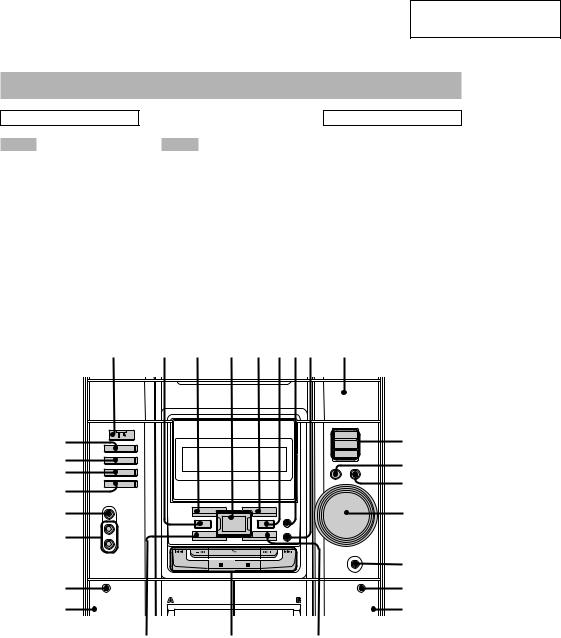
HCD-GX30/RG22/RG33
SECTION 1
GENERAL
This section is extracted from instruction manual.
Main unit
ALPHABETICAL ORDER
A – E
AUDIO jacks ws (24) CD wj(11, 12, 18) CD SYNC 7(18) Deck A w;(16, 17) Deck B qh (16 – 19) DISC 1 – 3 0(11, 12)
DISC SKIP/EX-CHANGE qa(10, 11)
Disc tray 9(10) DISPLAY 2(16, 21) EFFECT ON/OFF qj (20)
G – Z
GAME wf (22, 24) GAME EQ ql (20, 24) GAME MIXING 4 (22) GROOVE 6(20) MOVIE EQ 5(20) MUSIC EQ 9(20) PHONES jack qf
REC PAUSE/START 8(18) TAPE A/B wg(16, 18) TUNER/BAND wh(13 – 15, 18) VIDEO jack wd (24)
VOLUME control qd
BUTTON DESCRIPTIONS
?/1 (power) 1
ZOPEN/CLOSE qs Z(deck B) qg
M qk
.qk >qk Xqk N qk x qk m qk
Z(deck A) wa
12 3 4 5 678 9
wj |
|
0 |
wh |
|
qa |
wg |
|
|
|
qs |
|
wf |
|
|
|
|
|
wd |
|
qd |
ws |
|
|
|
|
qf |
wa |
|
qg |
w; |
|
qh |
ql |
qk |
qj |
4
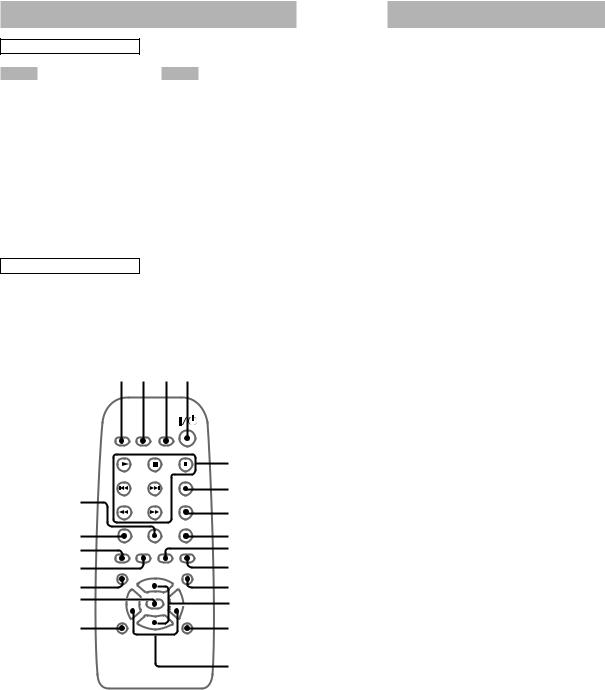
Remote Control
ALPHABETICAL ORDER
A – G
CD ql (11, 12, 18) CLEAR w; (12)
CLOCK/TIMER SELECT 2 (19, 23)
CLOCK/TIMER SET 9 (10, 19, 23)
DISPLAY 6 (16, 21) D.SKIP 7 (11)
ENTER qg (10, 12 – 14, 19, 23) EQ +/– qf (20)
GAME 0 (22, 24) GROOVE qd (20)
BUTTON DESCRIPTIONS
O – Z
ON/OFF qh (20)
PLAY MODE wa (11, 12, 17) PRESET +/– 5 (13 – 15) REPEAT 8 (11)
SLEEP 1 (22) STEREO/MONO 8 (15) SURROUND qa (20) TAPE A/B 9 (16, 18)
TUNER MEMORY qj (13, 14) TUNER/BAND qk (13 – 15, 18) TUNING +/– 5 (13 – 15)
VOL +/– qs
?/1 (power) 4 |
|
M 5 |
|
. 5 |
|
> 5 |
|
X 5 |
|
N 5 |
|
m 5 |
1 2 3 4 |
x 5 |
|
5 |
|
wa |
6 |
|
7 |
||
|
||
w; |
8 |
|
ql |
9 |
|
qk |
0 |
|
qj |
qa |
|
qh |
qs |
|
qg |
qd |
qf
HCD-GX30/RG22/RG33
Setting the clock
1 Press ?/1 to turn on the system.
2
3 Press . or > on the remote repeatedly to set the hour.
4 Press ENTER on the remote.
The minute indication flashes.
5 Press . or > on the remote repeatedly to set the minute.
6 Press ENTER on the remote.
The clock starts working.
To adjust the clock
1Press CLOCK/TIMER SET on the remote.
2Press . or > on the remote to select “CLOCK SET”, then press ENTER on the remote.
3Do the same procedures as step 3 to 6 above.
Note
The clock settings are canceled when you disconnect the power cord or if a power failure occurs.
5
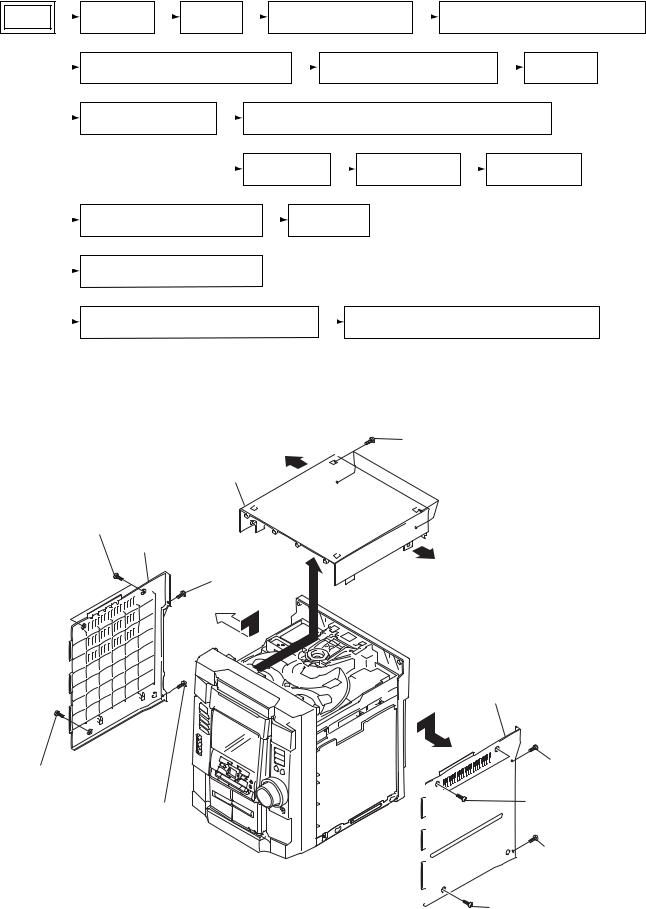
HCD-GX30/RG22/RG33
SECTION 2
DISASSEMBLY
Note : Disassemble the unit in the order as shown below.
SET |
|
|
CASE (TOP) |
|
CD DOOR |
|
|
|
FRONT PANEL SECTION |
|
|
|
CD MECHANISM DECK (CDM58F-K6) |
|
|||||||||||||||
|
|
|
|
|
|
|
|
|
|
||||||||||||||||||||
|
|
|
|
|
|
|
|
|
|
|
|
|
|
|
|||||||||||||||
|
|
|
|
TAPE MECHANISM DECK (CWL43FF48) |
|
|
REM BOARD AND PANEL BOARD |
|
|
KEY BOARD |
|||||||||||||||||||
|
|
|
|
|
|
|
|
||||||||||||||||||||||
|
|
|
|
|
|
|
|
|
|
||||||||||||||||||||
|
|
|
|
BACK PANEL SECTION |
|
|
|
SUB TRANS BOARD,SENSOR BOARD AND VIDEO BOARD |
|||||||||||||||||||||
|
|
|
|
|
|
|
|
|
|
MAIN BOARD |
|
|
|
POWER BOARD |
|
|
|
TRANS BOARD |
|||||||||||
|
|
|
|
|
|
|
|
|
|
|
|
|
|
|
|
||||||||||||||
|
|
|
|
CD BOARD AND DRIVER BOARD |
|
|
|
SPDL BOARD |
|
|
|
|
|
|
|
||||||||||||||
|
|
|
|
|
|
|
|
|
|
|
|
|
|
||||||||||||||||
|
|
|
|
OPTICAL PICK-UP (KSM-213DCP) |
|
|
|
|
|
|
|
|
|
|
|
|
|
|
|
|
|
|
|
||||||
|
|
|
|
|
|
|
|
|
|
|
|
|
|
|
|
|
|
|
|
|
|
|
|||||||
|
|
|
|
MOTOR BOARD, ADDRESS SENSOR BOARD |
|
|
TABLE (NEW),CAM (CONTROL) AND DC MOTOR |
||||||||||||||||||||||
|
|
|
|
|
|
||||||||||||||||||||||||
Note : Follow the disassembly procedure in the numerical order given.
2-1. Case (Top)
qa four screws (+BVTP 3 × 10)
qs
qf case (Top)
6 two screws (Case 3 TP2)
case (Side-L)
|
8 screw |
qs |
|
|
|
|
(+BVTP 3 × 8) |
qd |
|
|
|
|
q; |
|
|
|
case (Side-R) |
|
|
5 |
7 screw (Case 3 TP2) |
|
3 screw |
|
(+BVTP 3 × 8) |
|
9 screw |
|
1 two screws |
(+BVTT 3 × 8) |
|
(Case 3 TP2) |
|
|
4 screw |
|
|
(+BVTT 3 × 8) |
|
|
2 screw (Case 3 TP2) |
6
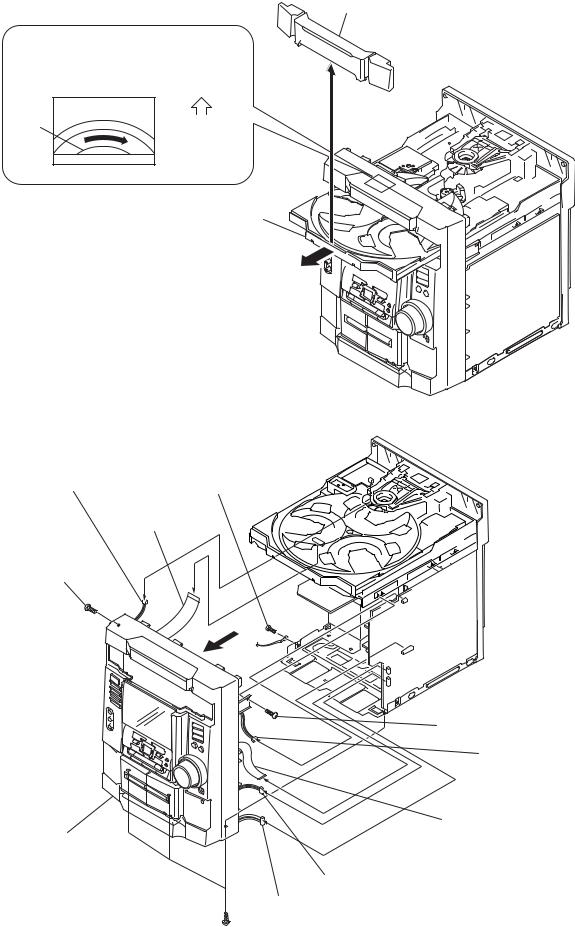
2-2. CD Door
CD mechanism deck (CDM58F-K6)
1 Turn the pulley to the direction of arrow.
Front panel side
pulley
2 Pull-out the disc tray.
HCD-GX30/RG22/RG33
4 CD door
3
2-3. Front Panel Section
6 connector 2p (CN682) |
4 screw (+BVTP 3 × 10) |
7 wire (flat type)
19p (CN733)
3 screw (+BVTP 3 × 10)
5
2 screw (+BVTP 3 × 10)
8 connector 3p (CN201)
9 wire (flat type) 13p (CN207)
qs front panel
0 connector 3p (CN303)
qa connector 7p (CN202)
 1 three screws (+BVTT 3 × 6)
1 three screws (+BVTT 3 × 6)
7
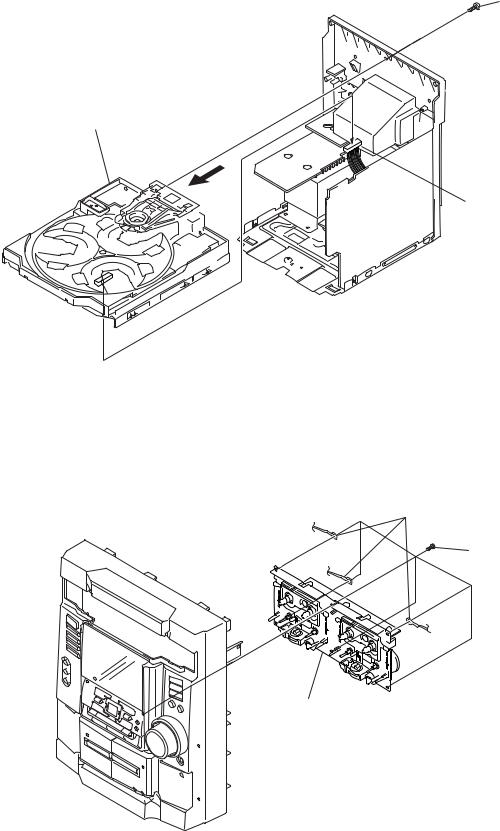
HCD-GX30/RG22/RG33
2-4. CD Mechanism Deck (CDM58F-K6)
1 screw (+BVTP 3 × 10)
4 CD mechanism deck (CDM58F-K6)
3
2 connector 7p (CN734)
2-5. Tape Mechanism Deck (CWL43FF48)
2 three ground wires
1 six screws (+BVTP 2.6 × 8)
3 tape mechanism deck (CWL43FF48)
8

HCD-GX30/RG22/RG33
2-6. REM Board and PANEL Board
two claws
claw
2
REM board
3 eight screws
6 REM board × (+BVTP 2.6 8)
four claws
5 Remove the soldering (three portions)
|
|
4 connector |
1 volume knob |
7 PANEL board |
13p (CN662) |
|
|
2-7. KEY Board
two claws
three claws |
2 KEY board |
|
1 four screws (+BVTP 2.6 × 8)
9
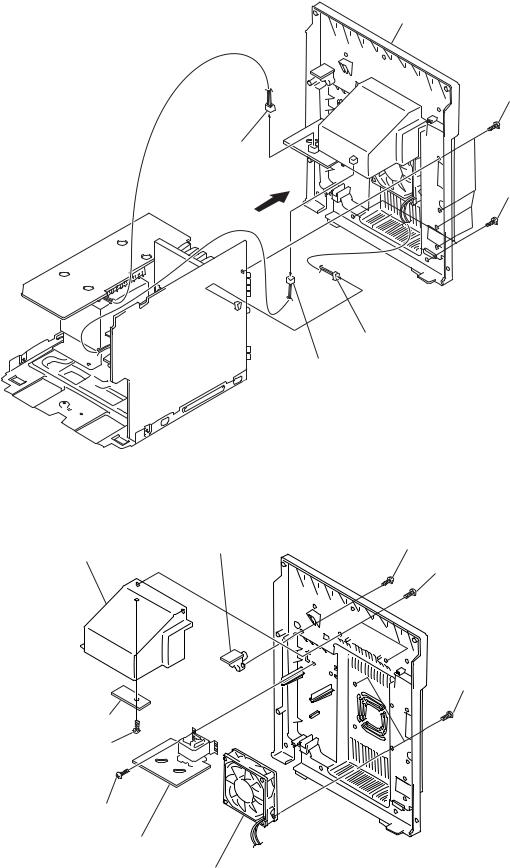
HCD-GX30/RG22/RG33
2-8. Back Panel Section
7 back panel
1 four screw (+BVTP 3 × 10)
3 connector
3p (CN903)
6 |
2 two screw |
× 6) |
|
(+BVTT 3 |
|||
|
4 connector
2p (CN301)
5 connector
2p (CN505)
2-9. SUB TRANS Board, VIDEO OUT Board and SENSOR Board
6 cover (duct) |
4 VIDEO board |
3 screw (+BVTP 3 × 10) |
|
||
|
|
|
|
|
5 two screws (+BVTP 3 × 10) |
9 two screws (+BVTP 3 × 10)
8 SENSOR board
7 screw (+BVTP 3 × 10)
1 screw (+BVTP 3 × 10)
2 SUB TRANS board
0 DC fan (M961)
10
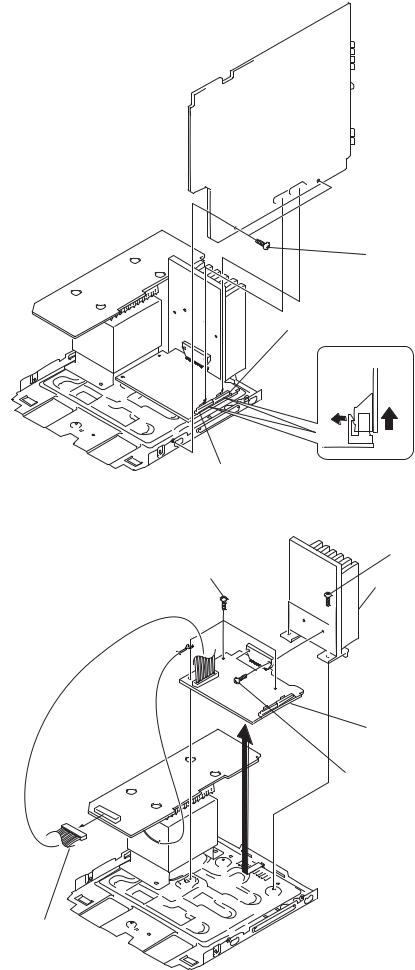
HCD-GX30/RG22/RG33
2-10. MAIN Board
 4 MAIN board
4 MAIN board
1 screw (+BVTT 3 × 6)
3 connector 13p (CN502)
Main board
2 connector 13p (CN503)
2-11. POWER Board
1 two screws (+BVTT 3 × 6)
2 three screws (+BVTT 3 × 6)
7 heat sink
6 POWER board
4 two screws (+BVTP 3 × 16)
3
5 connector 13p (CN915)
11

HCD-GX30/RG22/RG33
2-12. TRANS Board
2 two screws (+BVTT 4 × 6)
1 two screws (+BVTT 4 × 6)
3 TRANS board
2-13. CD Board and DRIVER Board
3 four screws (+BTTP M2.6 )
5 CD board
4
2 wire (flat type)
16p (CN731)
1 connector 10p (CN735)
6 Screw (+BTTP M2.6 )
8 DRIVER board
7 wire (flat type)
8p (CN702)
12
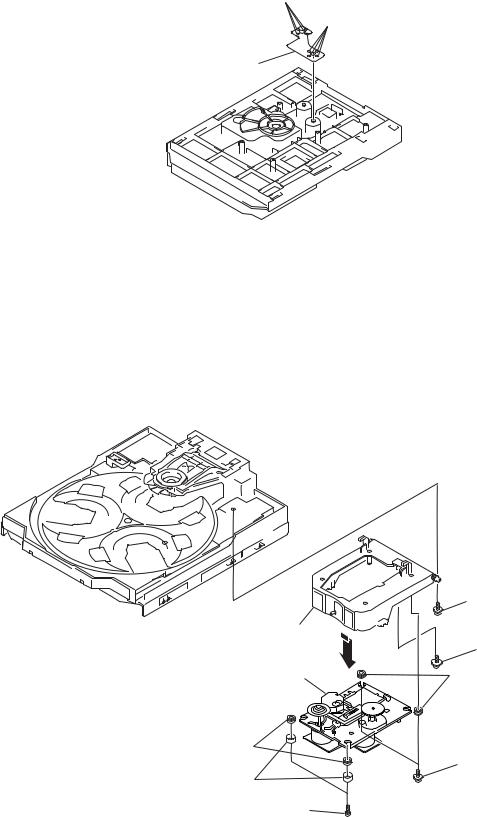
HCD-GX30/RG22/RG33
2-14. SPDL Board
1 Remove solder (four places)
2 Remove solder (four places)
3 SPDL board
2-15. Optical Pick-up (KSM-213DCP)
|
|
1 screw (+PTPWH M2.6) |
2 holder (BU) assy |
|
|
|
9 |
6 screw (DIA. 12) |
0 optical pick-up |
|
|
|
|
|
(KSM-213DCP) |
|
8 two insulators |
7 two insulators
5 two screws (+PTPWH M2.6)
4 two stoppers (BU)
3 two screws (+BTTP M2.6)
13
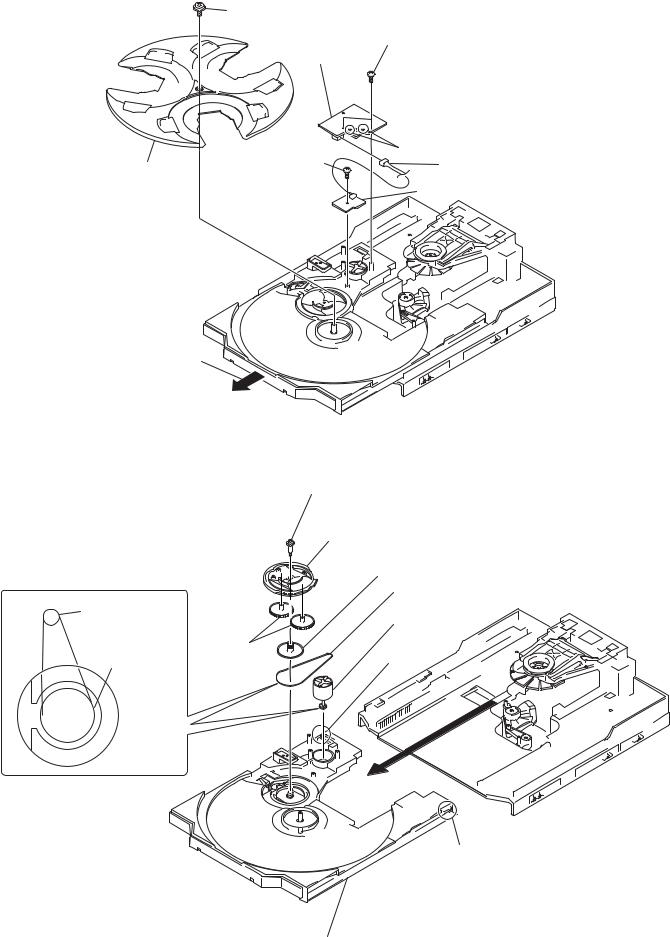
HCD-GX30/RG22/RG33
2-16. MOTOR Board, ADDRESS SENSOR Board
2 screw (+PTPWH 2.6 × 8)
5 two screws (+BTTP M2.6)
7 MOTOR board
|
|
6 Remove the two solderings of motor. |
3 tray |
8 screw (+BTTP M2.6) |
4 connector 4p (CN722) |
|
||
|
|
|
|
|
9 ADDRESS SENSOR board |
1 Pull out the disc tray.
2-17. Table (New), Cam (Control) and DC Motor
|
2 screw (STEP) |
|
3 cam (CONTROL) |
|
5 pulley (S) |
|
6 belt |
*Cautions of an assembly |
|
DC motor (TURN) |
7 DC motor (TURN) |
|
|
|
4 gear (U) |
pulley (S) |
claw |
|
claw
1 table (NEW)
14
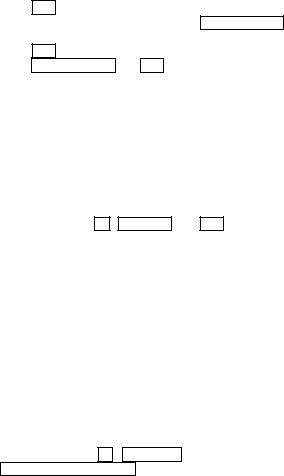
HCD-GX30/RG22/RG33
SECTION 3
TEST MODE
[Change-over of AM Tuner Step between 9 kHz and 10 kHz]
•A step of AM channels can be changed over between 9 kHz and 10 kHz. (Except AEP/UK models)
Procedure:
1.Press ?/1 button to turn the set ON.
2.Select the function “TUNER”, and press TUNER/BAND button to select the BAND “AM”.
3.Press ?/1 button to turn the set OFF.
4.Press TUNER/BAND and ?/1 buttons simultaneously, and the display of fluorescent indicator tube changes to “AM 9 k STEP” or “AM 10 k STEP”, and thus the channel step is changed over.
[Cold Reset]
•The cold reset clears all data including preset data stored in the RAM to initial conditions. Execute this mode when returning the set to the customer.
Procedure:
1.Press three buttons x , GROOVE , and ?/1 simultaneously.
2.The fluorescent indicator tube displays “COLD RESET” and the set is reset.
[Aging Mode]
This mode can be used for operation check of CD section and tape deck section.
•If an error occurred:
The aging operation stops and is displayed status.
•If no error occurs:
The aging operation continues repeatedly.
1.Operating method of Aging Mode
Turn on the main power and select “CD” of the function.
1)Set three discs in tray. Select ALL DISCS, and REPEAT OFF.
2)Load the tapes recording use into both decks.
3)Press three buttons x , GAME EQ , and DISC SKIP/EX-CHANGE simultaneously.
4)Aging operations of CD and tape are started at the same time.
5)To exit the aging mode, perform [Cold Reset].
2.Aging mode in CD section
1) Operation during aging mode
•In the agining mode ,the program is excuted in the following sequence.
(1)The disc tray opens and closes.
(2)The disc tray turns to select a disc 3.
(3)The pickup accesses to the first track, and plays 3 seconds.
(4)The pickup accesses to the last track, and plays 3 seconds.
(5)The disc tray opens and closes.
(6)The disc tray turns to select a disc 1.
(7)The same operation starts like step (3).
(8)After a disc 1 aging operation, a disc 2 is selected.
(9)When an aging operation of a disc 3 is completed, the display “AGING ” value increases.
(10)If no error occurs, the aging operation continues repeatedly.
2) Error display
|
Disc error |
Display |
Error |
|
|
E00D01022 |
Focus error (No disc) |
|
|
E00D02022 |
Sub Q error (Focus is good) |
E00D02023 |
TOC reading error |
|
|
E00D02014 |
Access error (Unable within regular time) |
|
|
|
Mechanism error |
Display |
Error |
E00M__E_0 |
Error during opening tray |
E00M__C_2 |
EX-CHANGE disc error |
E00M__D_0 |
Error during closing tray |
|
|
E00M__F_3 |
EX-OPEN error |
E00M__D_5 |
EX-CLOSE error |
|
|
E00M__C_2 |
Chuck-up error |
|
|
E00M__C_3 |
Unchucking error |
3.Aging mode in Tape Deck section
1) Operation during aging mode
•In the agining mode, the program is excuted in the following sequence.
Step |
Operation |
|
Display |
|
|
|
|
1 |
Rewind the TAPE A |
TAPE |
AAG-1 |
2 |
Rewind the TAPE B |
TAPE |
BAG-2 |
|
|
|
|
3 |
Play the TAPE A (1 minute) |
TAPE |
AAG-2 |
4 |
Stop the TAPE A (1 second) |
TAPE |
AAG-3 |
|
|
|
|
5 |
Play the TAPE A (3 minutes) |
TAPE |
AAG-4 |
6 |
Rewind(AMS) the TAPE A |
TAPE |
AAG-5 |
7 |
F.F.(AMS) the TAPE A |
TAPE |
AAG-6 |
|
|
|
|
8 |
Play the TAPE B (1 minute) |
TAPE |
BAG-2 |
9 |
Stop the TAPE B (1 second) |
TAPE |
BAG-3 |
|
|
|
|
10 |
Record the TAPE B (3 minutes) |
TAPE |
BAG-4 |
11 |
Rewind(AMS) the TAPE B |
TAPE |
BAG-5 |
12 |
F.F.(AMS) the TAPE B |
TAPE |
BAG-6 |
2) Error display
• If error occurred, the display remains like “TAPE BAG-2”.
4.Exiting from the aging mode
• Be sure to perform Cold Reset to exit from the aging mode.
15

HCD-GX30/RG22/RG33
[GC Test Mode]
•All fluorecent segments and LEDs are tested.
•Keyboard check.
Procedure:
1.Press ?/1 button to turn the set ON.
2.To enter the test mode, press the three buttons x , GAME EQ and DISC 2 simultaneously.
3.All segments and LEDs (without STANDBY LED) are turned on.
4.Press GAME EQ and DISC 2 buttons simultaneously, and the key check mode is activated.
5.The message “KEY 0 0 0 0” is displayed.
Each time a button is pressed, the key code number is displayed.
6.Press GAME EQ and DISC 2 buttons simultaneously, and the key count mode is activated.
7.The message “KEYCNT 0 1” is displayed.
Each time a button is pressed, “KEYCNT 0 1” value increased. However, once a button is pressed, it is no longer taken into account.
8.Press GAME EQ and DISC 2 buttons simultaneously, and the head phone detect mode is activated.
9.The message “H_P OFF” is displayed when a headphone jack is not inserted.
“H_P ON ” is displayed when a headphone jack is inserted.
10.Press GAME EQ and DISC 2 buttons simultaneously, and the volume control detect mode is activated.
11.The message “VOLUME FLAT” is displayed.
“VOLUME UP” is displayed if rotating VOLUME knob clockwise, or “VOLUME DOWN” is displayed if rotating counterclockwise.
12.To exit from the GC test mode after the volume control detect mode, press GAME EQ and DISC 2 buttons simultaneously.
[Version and Destination Display Mode]
• The version or destination is displayed.
Procedure:
1.Press ?/1 button to turn the set ON.
2.To enter the test mode, press the three buttons x , GAME EQ and MOVIE EQ simultaneously.
3.The destination is displayed.
4. Press STOP and GROOVE buttons simultaneously.
5.The version is displayed.
6.To exit from this mode, press ?/1 button to turn the set OFF.
[CD Service Mode]
•This mode can run the CD sled motor freely. Use this mode, for instance, when cleaning the pickup.
Procedure:
1. |
Press |
?/1 |
button to turn the set ON. |
||||||||
2. |
Select the function “CD”. |
||||||||||
3. |
To enter the test mode, press three buttons x , |
GAME EQ |
, |
||||||||
|
and |
OPEN/CLOSE |
simultaneously. |
||||||||
4. |
The CD service mode is selected. |
||||||||||
5. |
With the CD in stop status, press |
|
button to move the pickup |
||||||||
> |
|||||||||||
|
to outside track, or press |
|
|
+ |
|
|
|
||||
|
. |
button to inside track. |
|||||||||
|
|
|
|
|
|
– |
|
||||
6.To exit from this mode, perform as follows:
1)Move the pickup to the most inside track.
2)Press ?/1 button to turn the set OFF.
Note: • Always move the pickup to most inside track when exiting from this mode. Otherwise, a disc will not be unloaded.
•Do not run the sled motor excessively, otherwise the gear can be chipped.
[MC Test Mode]
• This mode is used to test the function of the equalizer.
Procedure:
1.Press ?/1 button to turn the set ON.
2.To enter the test mode, press the three buttons x , GAME EQ and DISC 3 simultaneously.
3.Press the MOVIE EQ button.
The function of the equalizer is set to “MIN”.
4.Press the MUSIC EQ button.
The function of the equalizer is set to “MAX”.
5.Press the P.FILE button.
The function of the equalizer is set to “FLAT”.
6.To exit from this mode, press ?/1 button to turn the set OFF.
[CD Ship Mode (No Memory Clear) ]
•This mode moves the pickup to the position durable to vibration. Use this mode when returning the set to the customer after repair.
Procedure:
1.Press ?/1 button to turn the set ON.
2.Select the function “CD”.
3.Press ?/1 button to turn the set OFF.
4. Press CD button and ?/1 button simultaneously.
5.The "STANDBY" display blinks instantaneously, and the CD ship mode is set.
16
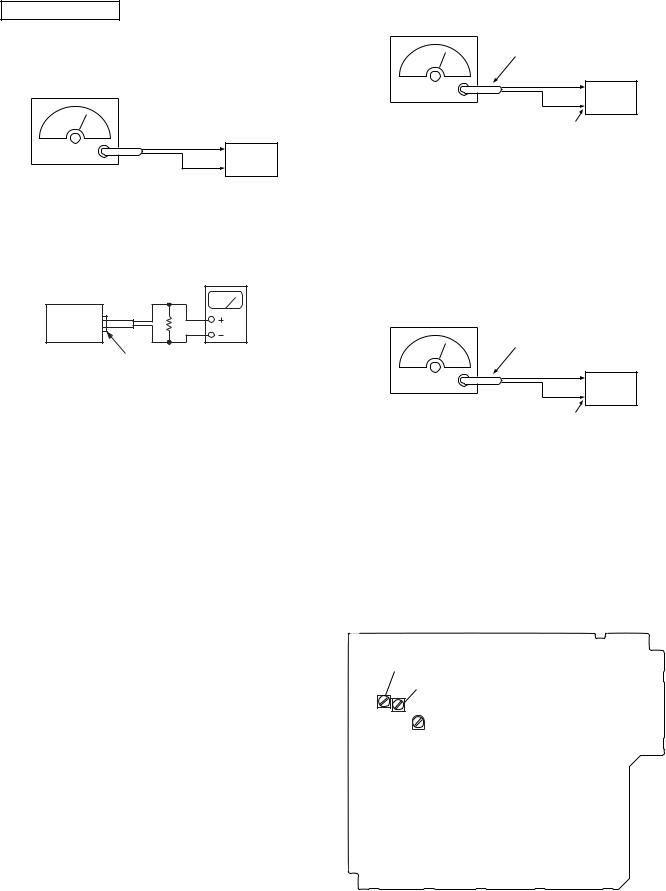
HCD-GX30/RG22/RG33
SECTION 4
ELECTRICAL ADJUSTMENTS
TUNER SECTION
AM IF Adjustment
AM RF Signal generator
|
set |
30% amplitude |
|
modulation by |
AM ANTENNA terminal |
400Hz signal |
(JK103) |
output level : as low as possible |
|
|
level meter |
|
16 Ω |
set |
|
|
headphones jack (JK691) |
Procedure:
1.Set the frequency of the AM RF signal generator to 1000 kHz (at 10 kHz step) or 999 kHz (at 9 kHz step).
2.Tune the set to AM 1000 kHz (at 10 kHz step) or 999 kHz (at 9 kHz step).
3.Adjust IFT101 so that the reading on level meter becomes in maximum.
FM Tuned Level Adjustment
FM RF Signal generator
75 Ω coaxial
Carrier frequency : 98 MHz
Modulation |
: AUDIO 1 kHz, 75 kHz |
|
deviation (100%) |
Output level |
: 30 dB (at 75 Ω open) |
set
FM ANTENNA terminal (JK103)
Procedure:
1.Supply a 98 MHz signal at 28 dB from the ANTENNA terminal.
2.Tune the set to 98 MHz.
3.Adjust RV101 to the point (moment) when the TUNED indicator will change from going off to going on.
Adjustment Location: MAIN board
Null Adjustment
FM RF Signal generator
75 Ω coaxial
Carrier frequency : 98 MHz
Modulation |
: AUDIO 1 kHz, 75 kHz |
|
deviation (100%) |
Output level |
: 60 dB (at 75 Ω open) |
set
FM ANTENNA terminal (JK103)
Procedure:
1.Supply a 98 MHz signal at 60 dB from the ANTENNA terminal.
2.Tune the set to 98 MHz.
3.Measure voltage between pin 21 and pin 23 of IC 101. Adjust T101 until the voltage becomes 0 V.
Adjustment Location: MAIN board
[MAIN BOARD] Component side
T101: NULL
IFT101: AM IF
RV101:
FM TUNED LEVEL
17
